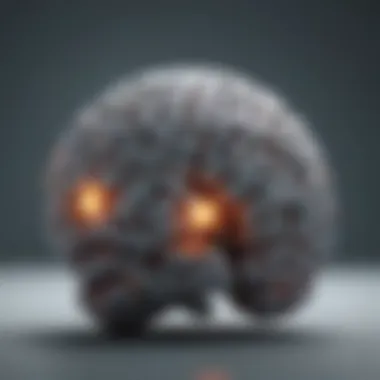Comprehensive Anxiety Medicine List and Overview


Intro
Anxiety disorders are prevalent, affecting countless individuals worldwide. Understanding the breadth of treatment options is essential for effective management. This overview presents a blend of established medicines and emerging therapies that aim to alleviate anxiety. As we delve into the complexities of anxiety medications, it becomes crucial to recognize the connection between mental health and overall well-being.
Understanding Mental Health and Well-being
What is Mental Health?
Mental health encompasses emotional, psychological, and social well-being. It impacts how individuals think, feel, and act. Additionally, it plays a pivotal role in perceptions, reactions, and coping mechanisms during life events.
The Importance of Prioritizing Mental Well-being
Prioritizing mental health is central to leading a fulfilling life. Good mental well-being bolsters resilience against stress and underpins the ability to maintain relationships. By emphasizing mental health, individuals may experience improvements in their physical health as well, as the two are closely connected.
Common Mental Health Challenges and Disorders
Anxiety disorders are among the most common mental health challenges today. Conditions range from generalized anxiety disorder to specific phobias. Identifying these challenges is key to seeking appropriate medication and therapy, potentially leading to more effective treatment outcomes.
Strategies for Improving Mental Health
Self-care Techniques and Practices
Self-care plays a significant role in managing anxiety. Focusing on healthy habits can be a first line of defense in mental health support. Activities such as reading, spending time in nature, and practicing hobbies cultivate well-being.
Building Resilience and Stress Management
Resilience is the ability to bounce back from adversity. Stress management strategies are crucial for building this trait. Techniques include deep breathing and identifying triggers to better handle stressful situations.
Seeking Professional Help: Therapy and Counseling
Professional help can provide significant relief. Therapy types vary, ranging from cognitive-behavioral therapy to more traditional forms of counseling. Establishing a trusting relationship with a mental health professional can pave the way for tailored treatment plans.
Finding Balance in Life
Healthy Lifestyle Choices: Diet, Exercise, and Sleep
A balanced lifestyle is imperative. Proper nutrition, regular exercise, and sufficient sleep contribute to better mental health. Food plays a role in regulating moods, while physical activity releases endorphins, organic chemicals in the body that improve feelings of well-being.
Mindfulness and Meditation Practices
Practicing mindfulness can enhance emotional control. Meditation techniques help ground individuals in the moment, reducing feelings of anxiety. Regular practice has proven beneficial for cognitive function and emotional balance.
Setting Boundaries and Managing Time Effectively
Learning to set boundaries is crucial in reducing anxiety-related stress. This can include defining working hours and social commitments. Effective time management alleviates overwhelm, contributing positively to mental health.
Enhancing Personal Development
Goal Setting and Productivity Tips
Goal-setting fosters motivation and gives structure to daily activities. SMART goals—Specific, Measurable, Achievable, Relevant, Time-bound—boast efficiency in pursuing objectives and tracking progress.
Building Healthy Relationships and Social Connections
Valuing connections with others directly influences mental health. Nurturing physical and digital relationships promotes a sense of community and support. Regular social interaction reduces feelings of isolation and enhances emotional well-being.
Practicing Gratitude and Positivity
Gratitude journaling can shift focus from negativity to positivity. Documenting daily highlights fosters contentment and creates a more optimistic viewpoint on life. Positive thinking contributes to overall mental wellness and equips individuals to handle stressful situations better.
Tips for Maintaining Mental Well-being
Strategies for Preventing Burnout
Ignoring signs of burnout can lead to more severe mental health issues. It's crucial to recognize indicators, allowing room for timely intervention. Regular breaks and intentional downtime help in managing energy and productivity.
Coping with Challenges and Setbacks
Investment in coping therapy or strategies is vital. Challenges are inevitable, and knowing how to manage setbacks adds resilience to personal narratives. Approaching obstacles with rationale can reduce their potential impact on mental health.
Creating a Supportive Environment
A supportive environment is foundational to well-being. Whether at home or work, fostering a space where individuals feel valued reaffirms self-worth. Continuous encouragement from those around promotes hope and motivation during difficult times.
Seeking support is a stalwart tool in managing anxiety effectively and can act as a stepping stone toward optimal healing.
Prolusion to Anxiety Disorders
Anxiety disorders are a significant mental health concern affecting millions globally. Acknowledging their complexity is essential for fostering a nuanced understanding of anxiety. This section lays the groundwork for reader comprehension, considering the various dimensions of anxiety, the triggers, and how they manifest in everyday life.
Understanding Anxiety
Anxiety, in its basic form, is a natural response to stress. It can be a temporary feeling triggered by a particular event or situation. However, when anxiety begins to interfere with daily functioning, it becomes a disorder. Many people experience excessive worrying, restlessness, or physical symptoms like rapid heartbeat. These reactions can impede regular activities, such as work, relationships, and leisure. It is crucial to differentiate between general feelings of anxiety and those that exemplify a disorder. A clinical diagnosis is often made based on persistent symptoms and their intensity over time.
Common symptoms of anxiety include:


- Increased heart rate
- Persistent worrying
- Fatigue
- Irritability
- Difficulty concentrating
Such manifestations can drastically reduce the quality of life, making it vital to address anxiety seriously through treatment and intervention.
Types of Anxiety Disorders
Diverse anxiety disorders exist within the mental health framework. Recognizing the distinctions is important for identifying maligant symptoms.
- Generalized Anxiety Disorder (GAD): GAD is characterized by chronic worrying about various life factors. This worry is difficult to control and can cause severe distress.
- Panic Disorder: Individuals with panic disorder experience unexpected panic attacks, which involve sudden feelings of terror. These often manifest with physical symptoms, such as chest pain or shortness of breath.
- Social Anxiety Disorder: This disorder involves excessive fear of social interaction. Individuals tend to fear scrutiny and may avoid situations where they might be judged.
- Specific Phobias: This class encircles intense fear from particular situations or objects, like heights or spiders. The fear is disproportionate to the actual danger the situation presents.
- Obsessive-Compulsive Disorder (OCD): In OCD, individuals have repetitive unwanted thoughts (obsessions) and behavioral responses (compulsions) aimed at reducing anxiety.
- Post-Traumatic Stress Disorder (PTSD): PTSD is a condition that some individuals develop after experiencing or witnessing a traumatic event. They might experience flashbacks and severe anxiety that may negatively influence their daily function.
Proactively seeking information about these sub-types enables better-informed discussions with healthcare professionals, paving the way for the right treatment approach.
The Role of Medications in Anxiety Treatment
Medications play a critical role in managing anxiety disorders. For many individuals, pharmacological treatments can provide significant relief from symptoms, allowing them to lead more productive lives. Anxiety disorders often manifest through persistent feelings of unease, fear, and relentless worry. In some cases, psychotherapy alone may not be enough to impose adequate control over these symptoms.
According to recent studies, 30% of adults will experience an anxiety disorder at some point in their lives. Consequently, understanding the options for treatment is crucial. This includes familiarizing oneself with available medications and their specific functions. A thorough policy and experience of healthcare professionals can aid individuals in making informed decisions about their treatments.
The decision to use medication should not be taken lightly. There are various types of treatments available, and it’s important to assess both the benefits and the potential drawbacks or side effects of medication.
Pharmaceutical interventions offer swift psychiatric relief whilst ongoing therapies encompass lasting behavioral changes.
Pharmacological Interventions
Pharmacological interventions encompass various categories of medications designed specifically to alleviate anxiety symptoms. These medications primarily target ligands in the neurochemical systems of the brain, including serotonin, norepinephrine, and GABA, ensuring balanced neurotransmission. Common medications prescribed for anxiety include selective serotonin reuptake inhibitors, serotonin-norepinephrine reuptake inhibitors, benzodiazepines, and others.
Each medication operates via distinct mechanisms, and its effectiveness may vary based on personal biology and the specific disorder diagnosed.
Benefits of Pharmacological Intervention
- Rapid Symptom Relief: Often, anxiety issues necessitate immediate management, which medications can provide effectively.
- Complement to Therapy: Medications often work hand in hand with other treatment forms, such as cognitive-behavioral therapy. This can result in significantly improved outcomes.
- Tailored Solutions: Many patients respond poorly to first-line treatments but may find success with different choices.
However, pharmacological interventions come with complexities, such as the risk of dependency, especially in the case of benzodiazepines. Therefore, ongoing consultations with healthcare professionals throughout the treatment duration are paramount.
Non-Pharmacological Considerations
Aside from medications, many individuals may consider non-pharmacological approaches to manage their anxiety. These strategies aim to address the cognitive, emotional, and physical dimensions of anxiety disorders.
Alternative Approaches Include
- Psychotherapy: Commonly recognized forms include cognitive-behavioral therapy. Therapy can enable patients to identify and change negative thought patterns contributing to anxiety.
- Mindfulness and Relaxation Techniques: Practices such as yoga, deep breathing exercises, and meditation can support symptom relief by promoting relaxation and reducing stress.
- Lifestyle Changes: Incorporating regular physical activity and a balanced diet can enhance overall well-being and reduce anxiety symptoms.
While withdrawing medications is sometimes favorable, some individuals find they require both medications and non-pharmacological treatments. The optimal approach often depends on the severity of the anxiety disorder and individual circumstances.
These considerations enhance the personal understanding of anxiety treatment options. Whether engaging in pharmacological or non-pharmacological strategies, this multifaceted approach can provide sustainable relief from anxiety symptoms.
Classes of Anxiety Medications
Understanding the classes of anxiety medications is crucial in the landscape of anxiety disorder treatment. These medications also referred to as anxiolytics, serve diverse functions and address different types of anxiety. They help in modulating neurochemical activity in the brain that often contributes to the manifestation of anxiety. Various classes have distinctive mechanisms, side effects, and suitability for particular patients. Thus, it’s of utmost importance to comprehend each class in order to make informed decisions with a healthcare provider.
Selective Serotonin Reuptake Inhibitors (SSRIs)
SSRIs have been a foundational treatment for anxiety disorders. They primarily function by inhibiting the reuptake of serotonin. This ensures an increased availability of serotonin, which is linked to mood regulation.
Common SSRIs
Some of the most prescribed SSRIs include Fluoxetine, Sertraline, and Escitalopram. Their wide usage results from evidence showing their effectiveness in treating generalized anxiety disorder, obsessive-compulsive disorder, and panic disorder. SSRIs are deemed popular because they typically have a favorable side effect profile compared to other medications. Their unique feature is the gradual onset of their effects, which sometimes can take weeks, but they avoid dependency issues common with faster-acting anxiolytics.
Mechanism of Action
The mechanism of action of SSRIs centers on serotonin levels. By blocking the serotonin transporter, they increase serotonin concentrations in the synaptic cleft. This action leads to mood stabilization and anxiety reduction. It's a dependable choice, given that many patients respond positively without experiencing severe side effects.
Indications and Dosage
SSRIs are indicated for various anxiety disorders, including major depressive disorder alongside anxiety conditions. Dosing typically begins at a low level, then progressively adjusted based on patient response and tolerability. The range of common dosages gives flexibility in tailoring treatment according to individual needs.
Serotonin-Norepinephrine Reuptake Inhibitors (SNRIs)
SNRIs also play an optimistic role in managing anxiety. This class works by affecting both serotonin and norepinephrine. This combination is beneficial for complexity in anxiety.
Common SNRIs
Popular SNRIs include Venlafaxine and Duloxetine. They contribute greatly to the pharmacological landscape. The dual-action of these medications often results in relief in symptoms that overlap with both depression and anxiety, consolidating their notable status in treatment regimens.
Mechanism of Action
SNRIs act by inhibiting the reuptake of serotonin and norepinephrine. This can, therefore, balance mood levels in a more comprehensive form. Their unique proposition is that they can enhance energy due to the involvement of norepinephrine, which may be beneficial alongside anxiety treatment.
Indications and Dosage
SNRIs are indicated for generalized anxiety disorder against depression and chronic pain issues. Dosage generally starts at a moderate level, allowing health practitioners to assess efficacy and safety.
Benzodiazepines
Benzodiazepines offer short-term relief for acute anxiety but require caution due to risks involved with long-term use.
Common Benzodiazepines


Drugs such as Lorazepam and Diazepam highlight the benzodiazepine class. They show effectiveness in rapid relief of anxiety symptoms. Their immediate action often makes them the first point of call for emergency settings.
Mechanism of Action
Benzodiazepines function by modulating GABA, a neurotransmitter that inhibits nerve activity. This is advantageous since it results in rapid sedation and anxiety relief. However, monitoring use to prevent dependency is essential, given their potent effects.
Appropriate Use and Risks
Because of their addictive potential, appropriate use of benzodiazepines should only be after professional guidance. They are best employed in acute situations, not as long-term solutions despite their effective anxiety reduction.
Buspirone
Buspirone has gained attention recently as an alternative to benzodiazepines for chronic anxiety management.
Mechanism of Action
By affecting serotonin receptors, specifically 5-HT1A, buspirone stabilizes anxiety without the sedating effects. This makes it a wise choice particularly for individuals needing longer-term therapy without rapid acting-liability. It’s gentle compared to traditional anxiolytics yet effective for disorders like generalized anxiety.
Indications and Dosage
Indicated primarily for chronic anxiety, dosages of buspirone need careful calibration, often starting at low levels to assess tolerance before eventual upward adjustment. It demands patience as improvement in symptoms may take longer compared to other methods.
Potential Benefits and Limitations
Buspirone’s benefits include less sedation, lower potential for addiction, and no crossover into issues with other anxiolytics. However, limitations such as the delayed onset effect and decreased potency might discourage immediate use for some patients.
Beta-Blockers
Though primarily used for cardiovascular issues, beta-blockers also find utilization in anxiety.
Common Uses in Anxiety
Beta-blockers like Propranolol specifically help manage performance-related anxiety, minimizing physical symptoms such as elevated heart rate or tremors. Their unique feature is how effectively they address anxiety signs without exerting typical anxiolytic ownership.
Mechanism of Action
The action via beta-adrenergic receptors slows the heart rate and decreases blood pressure. This directly translates to reduced physical anxiety sensations experienced during stressful scenarios—which many find particularly distressing.
Considerations and Side Effects
Using beta-blockers may also bring side effects like fatigue or dizziness, leading oversight necessary. Their potential contribution to treating specific situations remains valued, yet targeting general anxiety doesn't suit their properties well.
Antidepressants Beyond SSRIs and SNRIs
This final section discusses alternatives to first-line medication options. They hold lesser-known value but can aid particular audiences seeking other therapeutic effects. Based on health professionals' guidance on situational needs, they may offer viable routes for patients of varying backgrounds.
Tricyclic Antidepressants
Tricyclics such as Amitriptyline or Clomipramine target various symptoms by simultaneously blocking multiple neurotransmitter systems. They hold good qualities, yet the presence of side effects, distinct from SSRIs and SNRIs, makes them second-tier approaches.
Monoamine Oxidase Inhibitors (MAOIs)
Lastly, MAOIs like Phenelzine require rigid dietary observations due to risky interactions with other substances. They handle various mood aspects but need absolute diligence from patients and scholars alike.
Emerging Therapies for Anxiety Management
Emerging therapies for anxiety impact how conditions are understood and treated. The traditional view of anxiety medications has mostly included established drug classes. But, the search for more effective options continues. Research has now focused on innovative treatments that could provide relief for those who do not respond well to conventional therapies. This inclusion of newer compounds and approaches broadens the scope for effective management of anxiety disorders and benefits patients.
Psychedelic Substances
Research Developments
Research in psychedelic substances, such as psilocybin and MDMA, has gained traction. These substances show promise in treating various mental health issues, including anxiety disorders. Studies have suggested effects on serotonin receptors, which may lead to a decrease in anxiety symptoms. One strong aspect of this research is its innovative approach, likely appealing to those who seek alternatives when traditional treatments fall short. People have explored these substances after seeing limited success with other medications.
Nevertheless, it's vital to acknowledge the legal restrictions arr227ound these substances and the societal perceptions that can affect their overall use in relation to anxiety treatment. Continuing research aims to remove some of haed hurdles currently hindering wider acceptance.
Clinical Applications
The clinical application of psychedelic substances lives in their therapeutic contexts. For example, they may be utilized during sessions with qualified therapists to enhance the experience of patients. Their ability to induce significant emotional responses may help individuals process traumatic events or long-term stress. This unique dynamism stands out against common medication regimens odd often do not offer similar emotional connectivity. However, it is important to consider potential side effects and the need for thorough monitoring. Participants in studies should be carefully selected. Availability of licensed professionals for supervised use also proves a fundamental consideration in the deployment of these therapies.
Ketamine Treatments
Mechanism and Efficacy
Ketamine represents another cutting-edge treatment for anxiety management. It works differently than traditional antidepressants, affecting glutamate neurotransmission, rather than targeting serotonin or norepinephrine directly. This mechanism provides distinct synergy to various therapeutic strategies. The speed of its therapeutic effects is striking, as patients may experience relief from anxiety symptoms within short time frames. Though beneficial for many, it’s not universally appropriate or effective for everybody. Improper use can lead to unnecessary side effects, such as dissociation or altered perception. Careful patient evaluation is, thus, a top priority to ascertain suitability in calssifying it as a treatment option.
Ongoing Research and Trials
The landscape of ongoing research regarding ketamine focuses on defining its long-term effectiveness and safety profiles. Scientific community is exploring different dosages and treatment schedules to optimize outcomes for patients. As this research grows, insights emerge regarding the boundaries of ketamine as a treatment. Legal and healthcare policies will likely evolve as more conclusive findings are established. Although its use already represents a considerable step forward in anxiety treatment, the patient logistics and healthcare provisions for safe access will become crucial components in its practical application down the line.
The integration of emerging therapies like psychedelics and ketamine into anxiety management signifies evolving perspectives on mental health treatment, illuminating human resilience in challenging circumstances.
Monitoring and Managing Side Effects
Monitoring and managing side effects is a crucial aspect of treatment in anxiety disorders. With the various classes of anxiety medications available, each can induce specific side effects. Recognizing these side effects early can lead to necessary adjustments in the treatment plan. This proactive approach not only improves patient outcomes but also supports overall mental well-being.


Benefits of Monitoring Side Effects
Monitoring provides insights into the effectiveness and tolerability of medications. When individuals report side effects, healthcare professionals can evaluate whether a medication should be adjusted, substituted, or discontinued. Moreover, an awareness of potential side effects can also prepare patients mentally. Feeling prepared can lessen anxiety during treatment, making the experience more manageable.
Considerations About Side Effects
Users often worry about side effects leading to non-compliance with medication. Addressing these concerns during consultations builds trust between patients and healthcare providers. Creating a clear communication channel encourages reporting any issues encountered. More importantly, managing side effects can enhance the overall therapeutic experience. Improved management no only enhances adherence but also boosts the overall effectiveness of treatment efforts.
Common Side Effects of Anxiety Medications
Anxiety medications often lead to a variety of unwanted physical or psychological reactions. Some common side effects can include:
- Nausea: Many medications can cause feelings of nausea or upset stomach.
- Weight Changes: Some may experience weight gain or loss depending on the drug.
- Drowsiness: Sedative effects can result in daytime sleepiness, compromising daily functionality.
- Dry Mouth: Various medications can reduce saliva production, causing discomfort.
- Sexual Dysfunction: Some SSRIs and SNRIs might lower libido or cause performance difficulties.
Knowledge of these side effects helps individuals stay informed, allowing them to maintain frank discussions with their providers.
Strategies for Side Effect Management
To manage and mitigate side effects of anxiety medications, individuals and healthcare providers can consider the following strategies:
- Communicate Regularly: Keeping an open line of communication with medical providers is essential. Timing adjustments or changing medications promptly if severe side effects occur.
- Lifestyle Adjustments: Incorporating simple lifestyle changes can minimize some side effects—for instance, increasing fluid intake may help with dry mouth.
- Gradual Dosage Changes: Sometimes, professionals may recommend slowly increasing the dose. A gradual approach may help the body adjust and reduce adverse effects.
- Frequent Monitoring: Regular follow-ups to assess side effects ensures quick actions can be taken when necessary.
- Supplementary Supports: Using complementary therapies like acupuncture or talk therapy may help manage both anxiety and its medication side effects effectively.
Early detection and management of side effects empower individuals to retain their treatment regimen and improve overall mental health without experience fear of irrit.include=
en.wikipedia.org
britannica.com
reddit.com
facebook.com
Consultation with Healthcare Professionals
Consultation with healthcare professionals is a critical step for anyone confronting anxiety disorders. It's not merely a recommendation; rather, it is an essential process that involves dialogue, assessments, and decision-making tailored to individual needs. Engaging in conversations with physicians or psychiatrists ensures safety and efficacy in treatment options.
Benefits of Professional Consultation include tailored treatment plans, access to established therapies, and consideration of the patient's unique medical history.
These professionals are well-versed in the complexities of anxiety and can recommend drugs, therapy options, or lifestyle changes. Choosing the right combination may significantly impact an individual’s health trajectory. Recognizing signs of underlying issues that may not be immediately apparent can also stem from these discussions.
When working with a healthcare professional, considerations about medication should always come first. Understanding a patient's state of mental health improves medical recommendations. It allows practitioners to assess the appropriateness of medications like SSRIs, benzodiazepines, and others that can induce side effects or dependencies. Additionally, recommendations on therapy modalities—whether cognitive behavioral therapy or more recent approaches like mindfulness-based stress reduction—can stem from these professional assessments.
“Discussing openly about all symptoms and concerns creates a comprehensive view, paving the way for a robust treatment plan.” - Anonymous
Establishing a treatment plan not only includes what medications may be best but also encourages a holistic view of managing anxiety.
Establishing a Treatment Plan
Creating a solid treatment plan begins with assessments conducted by mental health professionals. These assessments could include structured interviews, questionnaires, or even physical examinations. Developing a plan ensures clarity on the course ahead, balancing various treatment options like medications and therapy, tailored for each individual.
An effective treatment plan includes the following steps:
- Diagnosis: Recognizing specific anxiety disorders to address.
- Medication Choices: Deciding on appropriate medications where necessary, focusing on mechanisms of action and known effects.
- Therapy Integration: Work in tandem with psychiatric treatments by including therapeutic interventions.
- Objectives: Clearly outlining what successful treatment looks like for the patient.
- Adjustments: Regular evaluations to recalibrate the approach based on feedback and observed outcomes.
An ongoing partnership not only helps adjust plans as required but also promotes the importance of adherence, which is fundamental for long-term improvements.
Importance of Regular Follow-Ups
Maintaining regular follow-up appointments is crucial for staying on the right path toward managing anxiety. These interactions help in monitoring the effectiveness of the treatment plan and making real-time changes if necessary.
Parameters for Follow-Ups include:
- Effects Monitoring: Evaluating both positive outcomes and negative side effects, ensuring patient's concerns are addressed promptly.
- Evaluating progress: Requests for updates can provide a more accurate picture of improvement.
- Medication Management: An opportunity to adjust dosages or switch medications, if they are not serving their intended purposes adequately.
- Continuous support: Follow-ups instill confidence and offer ongoing emotional and psychological support.
Lifestyle Modifications Alongside Medication
Living with anxiety is compicated, and while medications offer significant relief for many, lifestyle changes are also vital in managing anxiety disorders. Combining pharmacological treatments with lifestyle modifications can lead to more persiatent improvements in anxiety levels. This section will discuss two crucial lifestyle aspects: exercise and nutrition. Both can profoundly influence mental health, and understanding their roles may assist individuals in developing a harmonious plan for combatting anxiety.
Exercise and Mental Health
Regular physical activity serves as more than just a means of improving one's physique; it plays a major role in enhancing mental health. Exercise helps in releasing endorphins, chemicals in the brain that act as natural painkillers and mood elevators. This chemical reaction can create a sense of well-being that potentially lowers anxiety symptoms.
Engagement in aerobic exercises like jogging, cycling, or swimming may particularly benefit mood enhancement. Some physical activities also include elements of mindfulness. Yoga is a prime example where breathing exercises and stretchng help center the mind and ease anxiety.
Benefits of exercise include:
- Reduced symptoms of anxiety and depression
- Increased resilience to stress
- Better self-esteem and body image
- Enhanced social interaction when exercised in groups.
Doctors often recommend around 150 minutes of moderate aerobic activity weekly. Simple tasks such as brisk walking or gardenng can suffice. Adopting a consistency in exercise routines can make a significant impact on one's mental well-being in conjunction with prescribed medications.
Nutrition and Anxiety
Diet also has a peculiar but important relationship with anxiety. Nutrition affects not only physical energy levels but also mental clarity and mood stability. A balanced diet helps regulate neurotransmitters in the brain, elements that are impacted by what we eat. Certain vitamins and minerals, such as Omega-3 fatty acids, magnesium, and zinc, have promising evidence relatking mood stabilization.
Foods to consider incorporating for better mental health include:
- Fatty fish (like salmon and sardines)
- Leafy greens (spinach and kale)
- Whole grains (quinoa and brown rice)
- Berries and nuts.
Avoiding processed foods, sugary snacks, and excess caffeine might contribute to reduced anxiety levels. Overall, a mindful approach to eating—understanding what you fuel your body with—fosters better mental and emotional balance.
The integration of lifestyle changes with medication can significantly strengthen your overall path to improved mental health.
End
The conclusion of an article about anxiety medications serves multiple vital purposes. Firstly, it distills the extensive information covered in the preceding sections into digestible insights. This helps reinforce the reader's understanding and retention of crucial facts related to anxiety treatment. More importantly, it emphasizes the significance of recognizing anxiety not only as a mental health issue but also as a multifaceted condition requiring comprehensive management.
A review of anxiety treatments, whether medication-based or non-pharmacological, illustrates the variety of options available to individuals seeking effective therapies. Effective maintenance of mental health often relies on a tailored approach, where medications complement lifestyle choices and therapeutic strategies. This integration supports the need for personal management plans informed by healthcare professionals.
Furthermore, various medications outlined in this article—including SSRIs, SNRIs, and benzodiazepines—along with emerging therapies like psychedelics and ketamine treatments, contribute to a more nuanced understanding of this treatment landscape. Being aware of each medication’s purpose and possible side effects can empower patients to make informed decisions and engage meaningfully with their health care providers about their treatment journey.
"The landscape of anxiety treatment is continually evolving, offering hope through both advancements in medications and a deeper understanding of mental health strategies."
Essentially, the conclusion strengthens the premise that effective management of anxiety can lead to significant enhancements in the quality of life. Through engaging in productive conversations with medical professionals, individuals can create customized treatment pathways that acknowledge their unique needs to aid in overcoming their anxiety. Emerging therapies may inspire optimism, yet ongoing dialogue and reassessment remain central to ensuring treatment effectiveness.
In summary, the multifaceted approach outlined throughout the article reflects the continuous effort required for promoting mental wellness. Initiating and maintaining a personalized anxiety treatment plan, grounded in comprehensive knowledge and regular assessments, is crucial for fostering improved mental health outcomes.















